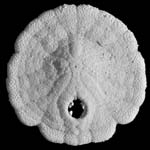Sand dollar echinoids first appeared in the fossil record during the Middle Eocene, but rapidly dispersed and are known globally by the end of the Eocene. The unique flattened form of the test is well-adapted to near-shore environments with strong bottom currents. They burrow very shallowly in the sand and can aggregate in immense numbers, often right at the beach edge in only a few centimeters of water. They are commonly washed up on beaches and are a favorite collector’s item for beachcombers.
Two species of Encope are recognized from the coastal waters of the northern Gulf of Mexico: the five-notched sand dollar, E. michelini L. Agassiz 1841 and the arrowhead sand dollar, E. aberrans Martens 1867. The two species are very similar, are sympatric in distribution (although individual populations show only slight overlap), and have often been confused (Phelan, 1972; Serafy, 1979; Hendler, et al., 1995). The adults can be distinguished primarily by the presence (E. michelini) or absence (E. aberrans) of 3 well-developed indentations or notches in the anterior test margin. Recognition of juveniles is problematic.
The genus Encope is a member of the echinoid order Clypeasteroida, and the suborder Scutellina (Mooi, 1989). A unique character of scutelline sand dollars is the presence of an intestinal diverticulum. This structure consists of a tubular caecum which is attached to the small intestine (Mooi and Chen, 1996) and runs around the test, between the intestine and the margin, in a counter-clockwise direction (when viewed from the aboral side). The diverticulum has peripheral pouches that may become filled with sand and heavy mineral grains in juvenile sand dollars. It has been hypothesized that the diverticulum, when distended with sand and mineral grains, acts as a “weight belt” (Chia, 1973).
Another character found in Clypeasteroida is the jaw apparatus or Aristotle’s Lantern, consisting of five teeth and various other calcareous elements (Hyman, 1955). The clypeasteroid lantern is more compact than the lanterns found in regular sea urchins, and especially so in the sand dollars where the flattened test constrains the available volume for the lantern.
Finally, all of the sand dollars are characterized by the development of calcareous supports in the test interior. Consisting in juveniles of a few buttresses or pillars, in the adult the buttresses expand to fill most of the interior space, leaving little room for the Aristotle’s lantern, digestive system, and gonads. The adult Encope can be surprisingly heavy because of the mass of interior calcareous buttressing. Although buttressing clearly adds strength to the test, it may also serve as added weight, replacing the mineral “weight belt” found in juveniles.
Additional Information on the Morphology of Encope

About the Species
|
This specimen (TMM NPL-4112) is the second largest in the series. All four specimens are deposited in the Nonvertebrate Paleontology Laboratory of the Texas Memorial Museum and were made available to the University of Texas High-Resolution X-ray CT Facility for scanning by Louis Zachos of the Department of Geological Sciences, The University of Texas at Austin. Funding for scanning was provided by a National Science Foundation Digital Libraries Initiative grant to Dr. Timothy Rowe of the Department of Geological Sciences, The University of Texas at Austin. |
The specimens were collected live just after high tide on the shoreline at Grayton Beach, Florida. This location is on the Gulf of Mexico, between Panama City and Pensacola, in the Florida Panhandle. Although differing in size, the specimens all probably belong to the same cohort. Such variability in size is common. The specimens were dried in air and preserve much of the original organic material, although most of the tiny spines have fallen off.
The specimens represented here have all been referred to E. michelini based on the presence in the larger specimens of the 3 anterior notches (in addition to the 2 posterior notches). However, the details of notch development for these species are not known, and the specimens may represent E. aberrans. Adults of both species have been found at different times in the same general location of Grayton Beach, Florida. While these juveniles range in size from 9mm to 16mm, adults of both species exceed 100mm in length.

About this Specimen
The specimen was scanned by Matthew Colbert on 23 January 2006 for a total of 125 slices along the horizontal axis. Each 1024x1024 pixel slice is 0.0197 mm thick, with an interslice spacing of 0.0197 mm and a field of reconstruction of 15.5 mm.

About the
Scan
Literature
Chia, F-S. 1973. Sand dollar: A weight belt for the juvenile. Science 181:73-74.
Hendler, G., J. E. Miller, D. L. Pawson, and P. M. Kier. 1995. Sea Stars, Sea Urchins, and Allies: Echinoderms of Florida and the Caribbean. Smithsonian Institution Press, Washington, D.C., 390 pp.
Hyman, L. H. 1955. The Invertebrates: Echinodermata, The Coelomate Bilateria, Volume IV. McGraw-Hill Book Co., New York, 763 pp.
Mooi, R. 1989. Living and Fossil Genera of the Clypeasteroida
(Echinoidea: Echinodermata): An Illustrated Key and Annotated Checklist.
Smithsonian Contributions to Zoology 488:51.
Mooi, R., and C-P. Chen. 1996. Weight belts, diverticula, and the phylogeny of the sand dollars. Bulletin of Marine Science 58:186-195.
Phelan, T. F. 1972. Comments on the echinoid genus Encope, and a new subgenus. Proceedings of the Biological Society of Washington 85:109-130.
Serafy, D. K. 1979. Echinoids (Echinodermata: Echinoidea). Memoirs of the Hourglass Cruises 5(Part 3):120.
Links
The Echinoid Directory (Natural History Museum, London)
The CAS Echinoderm Webpage (California Academy of Sciences)
The Virtual Echinoderm Newsletter (National Museum of Natural History)
Echinoderm discussion list (Swedish Museum of Natural History)

Literature
& Links
 |
Click on the thumbnail to the left for a horizontal cutaway animation (2 mb) of the specimen with the weight belt and Aristotle's lantern digitally removed. |

Additional
Imagery


